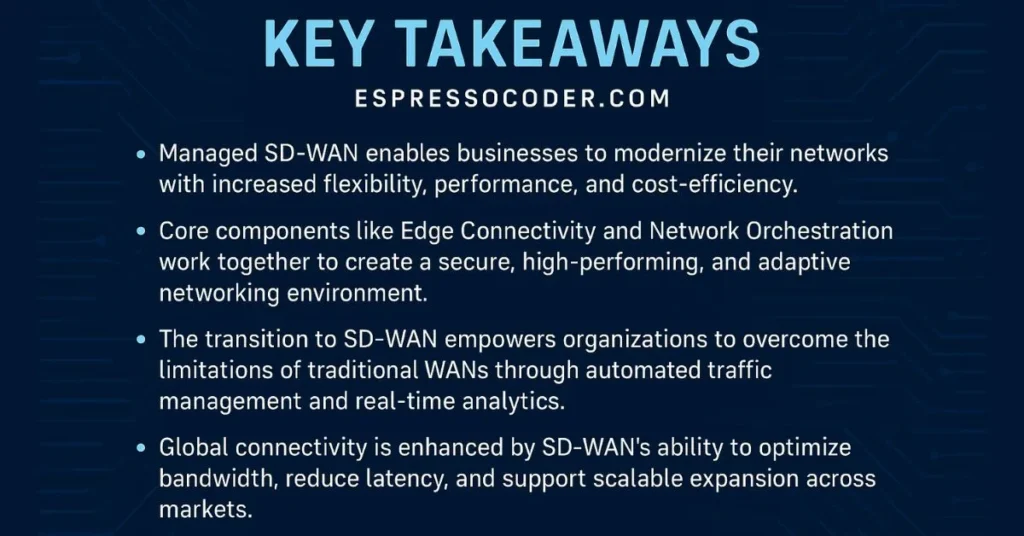Key Takeaways
- Managed SD-WAN enables businesses to modernize their networks with increased flexibility, performance, and cost-efficiency.
- Core components like Edge Connectivity and Network Orchestration work together to create a secure, high-performing, and adaptive networking environment.
- The transition to SD-WAN empowers organizations to overcome the limitations of traditional WANs through automated traffic management and real-time analytics.
- Global connectivity is enhanced by SD-WAN’s ability to optimize bandwidth, reduce latency, and support scalable expansion across markets.
- Emerging technologies like AI and machine learning will further evolve SD-WAN, creating intelligent, self-healing, and future-ready network infrastructures.
Contents
Introduction to Managed SD-WAN
The demand for agile and efficient networking solutions has reached new heights, prompting businesses worldwide to seek innovative alternatives. The rise of SD-WAN as a managed service marks a significant shift in how organizations address these needs. Unlike traditional networking models tethered to legacy infrastructure, SD-WAN offers a tailored approach, optimizing data flow and enhancing the flexibility essential for modern-day operations.
Companies adopting this managed service model gain a competitive edge through seamless transitions, reduced operational costs, and scalable solutions. The key lies in moving away from archaic WAN setups and embracing SD-WAN’s potential for agility, which helps enterprises keep pace with ever-changing technological landscapes.
Components of Managed SD-WAN
At the heart of SD-WAN lies a set of components designed to deliver superior performance and reliability. First, SD-WAN Edge Connectivity functions as the initial barrier for data entering the network, ensuring secure and efficient passage of information. This component acts as a traffic cop, directing data packets with precision to their destinations.
Network Orchestration takes the baton from Edge Connectivity, providing centralized control over network activities. This orchestration enables businesses to respond swiftly to network changes and allows for easy integration with cloud services. The synergy of these components creates a robust networking framework that empowers companies to adapt and thrive.
Why Businesses Are Switching to SD-WAN
The transition to SD-WAN is not merely a trend but a requisite for any forward-thinking organization. Traditional WANs often falter in providing the bandwidth efficiency and seamless connectivity needed in today’s hyperconnected world. As explored in NetworkWorld, SD-WAN addresses these shortcomings by offering automated traffic management and faster adaptation to business needs.
This technology’s ability to prioritize critical applications and provide real-time analytics transforms how enterprises manage their network resources. The easy implementation and cost reduction offered by SD-WAN further amplifies its appeal, making it an attractive proposition for businesses eager to streamline operations.
Benefits of Global Connectivity Through Managed SD-WAN
Businesses with a global presence thrive on robust and uninterrupted connectivity—a promise fulfilled by managed SD-WAN solutions. Beyond mere connectivity, SD-WAN enhances overall network efficiency by strategically allocating bandwidth and eliminating latency issues. This ensures that enterprises can maintain their operational tempo without fear of disruption.
Another significant advantage is cost savings, as SD-WAN allows businesses to leverage less expensive internet connections while maintaining high service quality. These factors combined create an environment where companies can expand their global footprint seamlessly, accessing new markets without the hurdles associated with traditional WAN infrastructures.
Real-World Examples of SD-WAN Use
Practical applications of SD-WAN technology demonstrate its potential across various sectors. Consider a multinational retailer that transitioned to SD-WAN to unify its dispersed network. This transition not only resulted in substantial cost savings but also enhanced network reliability across its stores worldwide, illustrating the tangible benefits of SD-WAN deployment.
In sectors such as finance, SD-WAN has proven instrumental in ensuring secure, high-speed connections essential for real-time data processing. Cases like these underscore the versatility and value that SD-WAN brings to the table, helping enterprises maintain robust, efficient, and scalable networks.
The Role of Managed Services in SD-WAN
Incorporating managed services into SD-WAN deployments elevates the overall network experience. These services provide continuous monitoring, proactive issue resolution, and maintenance, allowing businesses to focus on core operations while ensuring that their network functions optimally. Managed services reduce the need for extensive in-house IT resources, offering expert management that enhances network resilience.
This partnership between SD-WAN and managed services is crucial, as it not only ensures operational excellence but also fosters innovation by freeing up enterprises to explore new technologies and solutions without being bogged down by network challenges.
Future Trends in SD-WAN Technology
The leap to future-proof networking is driven by advancements that promise to redefine connectivity norms. According to insights from TechRepublic, AI, and machine learning integration are set to play pivotal roles in enhancing SD-WAN. These technologies are expected to bring about highly secure, adaptive, and self-healing networks.
Emerging trends also suggest a more robust alignment with cloud-native applications and increased emphasis on cybersecurity. The deployment of these innovations within SD-WAN frameworks promises an expansive reimagining of how networks operate, keeping them future-ready and resilient amid evolving challenges.
Conclusion
In conclusion, the outlook for managed SD-WAN in global connectivity is both promising and transformative. As organizations continue to seek flexible, high-performance solutions, SD-WAN stands out for its ability to modernize and streamline complex networks. By combining advanced features with managed services, businesses gain a scalable and resilient foundation for growth in the digital age.
Looking ahead, the evolution of SD-WAN will be driven by intelligent automation and deep integration with emerging technologies like AI and cloud-native platforms. These advancements will further enhance the agility, security, and efficiency of global networks. Ultimately, managed SD-WAN is poised to become a cornerstone of global digital infrastructure, empowering enterprises to thrive in a hyperconnected world.

